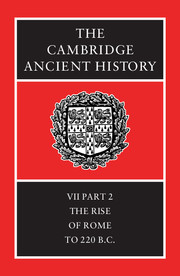Book contents
- Frontmatter
- 1 The Sources for Early Roman History
- 2 Archaic Rome Between Latium and Etruria
- 3 The origins of Rome
- 4 Rome in the fifth century I: the social and economic framework
- 5 Rome in the fifth century II: the citizen community
- 6 Rome and Latium to 390 B.C.
- 7 The recovery of Rome
- 8 The conquest of Italy
- 9 Rome and Italy in the early third century
- 10 Pyrrhus
- 11 Carthage and Rome
- 12 Religion in Republican Rome
- Appendix
- Chronological Table
- BIBLIOGRAPHY
- Index
- Fig. 50:The city of Rome in the early third century b.c.
- Map 11: The western Mediterranean in the third century
- References
3 - The origins of Rome
Published online by Cambridge University Press: 28 March 2008
- Frontmatter
- 1 The Sources for Early Roman History
- 2 Archaic Rome Between Latium and Etruria
- 3 The origins of Rome
- 4 Rome in the fifth century I: the social and economic framework
- 5 Rome in the fifth century II: the citizen community
- 6 Rome and Latium to 390 B.C.
- 7 The recovery of Rome
- 8 The conquest of Italy
- 9 Rome and Italy in the early third century
- 10 Pyrrhus
- 11 Carthage and Rome
- 12 Religion in Republican Rome
- Appendix
- Chronological Table
- BIBLIOGRAPHY
- Index
- Fig. 50:The city of Rome in the early third century b.c.
- Map 11: The western Mediterranean in the third century
- References
Summary
THE PROBLEMS OF CONTEXT
The question whether Rome was a Greek polis was asked in Greece in the fourth century B.C. by scholars like Heraclides Ponticus who at least in theoretical terms were well qualified to answer (Plut. Cam. 22). An alternative question was suggested by other Greek scholars whom Dionysius of Halicarnassus leaves unidentified (Ant. Rom. 1.29.2): whether Rome was or had been an Etruscan polis. The definition of Rome as a Greek polis evidently still appealed to philhellenic historians such as the senator C. Acilius (?) in the second century B.C., when Rome was turning into an empire of unprecedented structure (Jac. FGrH 813 fi). On the other hand the question of Etruscan influence on Roman institutions and customs was still very much in the mind of historians like Strabo (v.2.2, pp. 219–20C). These alternative interpretations – of Rome as a Greek city or as an Etruscan city – remain significant for us too. But we are now more aware of one of the difficulties inherent in the opposition: the Etruscans themselves developed their cities with an eye to Greek models.
As we know, between approximately 850B.C. and 700 B.C. a profound social transformation started in Greece and spread to Italy, the outcome of which was the creation of the classical city-state. Initially this transformation involved the displacement of groups which either went to remote places, often overseas, in what we call colonization or simply created a new town in the neighbourhood where they used to live. Forcible removal of inhabitants from one place to another was not excluded. The technological conditions of these developments are not always evident.
Keywords
- Type
- Chapter
- Information
- The Cambridge Ancient History , pp. 52 - 112Publisher: Cambridge University PressPrint publication year: 1990
References
- 5
- Cited by



